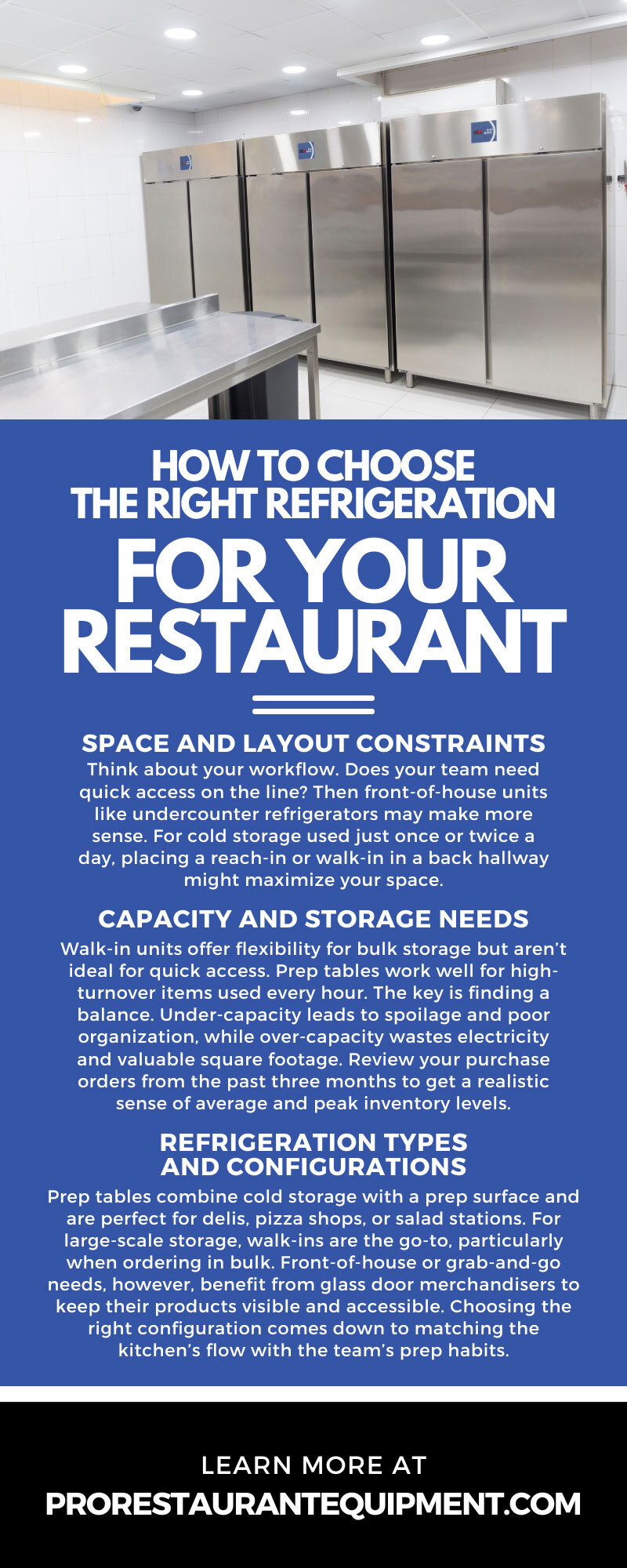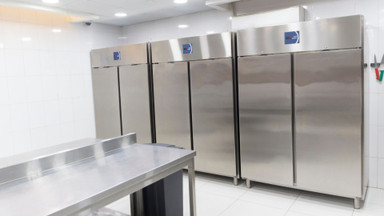Sep 10th 2025
How To Choose the Right Refrigeration for Your Restaurant
Picture this: a Friday night rush, your prep station is backed up, and half the line is waiting on ingredients that should’ve been chilled in arm’s reach. Worse yet, a walk-in unit overloaded with produce fails to keep its temperature, and now your inventory is compromised. These are the kinds of avoidable pitfalls that start with the wrong refrigeration choice.
If you’re wondering how to choose the right refrigeration for your restaurant, let’s break down some of the key factors to keep in mind.
Space and Layout Constraints
Before diving into models or features, assess the physical realities of your kitchen. Measure entryways, hallways, and ceiling heights, as some units won’t be able to make it through a door without disassembly.
Also, take note of where the refrigeration unit will sit in the kitchen. Tight corners, low clearance, or shared walls with hot equipment can interfere with ventilation and shorten compressor lifespan.
Think about your workflow. Does your team need quick access on the line? Then front-of-house units like undercounter refrigerators may make more sense. For cold storage used just once or twice a day, placing a reach-in or walk-in in a back hallway might maximize your space.
Regardless of your unit choice, be sure to leave at least two inches of clearance around the condenser coils to ensure proper airflow and prevent heat buildup.
Capacity and Storage Needs
Capacity should match the pace of the kitchen, not just on a typical Tuesday, but during holiday weekends, seasonal rushes, or catering prep. If a unit is overstuffed by the afternoon every day, it’s likely working harder than it should, putting food and its own parts at risk.
Walk-in units offer flexibility for bulk storage but aren’t ideal for quick access. Prep tables work well for high-turnover items used every hour. The key is finding a balance. Under-capacity leads to spoilage and poor organization, while over-capacity wastes electricity and valuable square footage. Review your purchase orders from the past three months to get a realistic sense of average and peak inventory levels.
Refrigeration Types and Configurations
Each unit type serves a different function. Reach-in refrigerators are versatile and fit well in most kitchen designs. They’re great for storing prepped ingredients or sauces, but are not ideal for high-volume turnover. Undercounter units maximize small footprints and allow staff to stay on the line without breaking stride.
Prep tables combine cold storage with a prep surface and are perfect for delis, pizza shops, or salad stations. For large-scale storage, walk-ins are the go-to, particularly when ordering in bulk. Front-of-house or grab-and-go needs, however, benefit from glass door merchandisers to keep their products visible and accessible. Choosing the right configuration comes down to matching the kitchen’s flow with the team’s prep habits.
Cuisine and Food Handling Requirements
Not all foods require the same handling or temperatures. Fresh seafood and meat demand colder storage (between 34 and 37 degrees Fahrenheit), while fresh herbs, dairy, and baked goods can tolerate slightly warmer zones. If you prep sushi, raw oysters, or charcuterie, rapid chilling is imperative to keep those ingredients safe and within code.
Your cuisine type also affects prep volume. A high-end steakhouse might need a dedicated meat cooler, while a taqueria may prioritize space for produce and tortillas. Consider whether you need specialty drawers or split-compartment units to store ingredients at varying temperatures. Some operations also benefit from backup freezers to hold overflow during 48-hour prep cycles.
Energy Efficiency and Operating Costs
Refrigeration systems are one of the largest contributors to a restaurant’s utility bill. Choosing high-efficiency models can cut those costs dramatically. ENERGY STAR–certified units are a good starting point, but you’ll also want to compare compressor types, insulation thickness, and annual kWh ratings.
Advanced features like adaptive defrost systems and digital temperature monitoring help minimize compressor runtime. When a restaurant operates 18 hours per day, that efficiency translates into hundreds of dollars saved per year. Low-emissivity (Low-E) glass doors on display fridges can also reduce thermal gain while maintaining product visibility.
Ambient Temperature and Kitchen Conditions
Many kitchens overlook the effect of ambient heat on fridge performance. Placing refrigeration units near fryers, ovens, or dishwashers can add 10 to 15 degrees Fahrenheit to the surrounding air. Any unit that isn’t rated for a higher ambient range—ideally 100 degrees Fahrenheit or more—may cycle excessively or fail to maintain safe food temperatures.
Restaurants in hot or humid climates should also prioritize models with corrosion-resistant evaporator coils and heated condensate pans. Without these, internal moisture can lead to mold growth or coil icing. In walk-ins, consider installing strip curtains or air curtains to limit thermal loss during heavy prep times.
Cleaning and Maintenance Needs
Health inspections don’t leave room for shortcuts, and refrigeration is often one of the first things checked. To stay compliant, clean the interior and exterior of each unit once per day and complete a more thorough sanitation process once per week. Walk-ins require floor-to-ceiling cleaning with degreaser every seven days.
When shopping, prioritize features that reduce labor. Recessed handles, removable gasket tracks, and coved interior corners all make cleaning faster and more thorough. Avoid textured or porous interior surfaces that can trap food particles. If your crew handles cleaning at closing, units with built-in LED lighting improve visibility and reduce oversight.
Routine maintenance should also include monthly coil cleanings, quarterly drain inspections, and biannual gasket replacements. Models with front-facing service panels and self-diagnostics will shorten these tasks significantly and reduce the team’s reliance on third-party repair techs.
Durability and Construction Quality
Durability isn’t just about longevity; it also affects food safety. A warped door or broken seal can allow temps to creep above 40 degrees Fahrenheit, especially during a busy lunch rush. Look for units with heavy-duty door hinges rated for at least 250,000 openings and self-closing mechanisms to prevent accidental exposure.
Interior components should be NSF-rated, and drawer glides should handle at least 100 pounds without sticking. For fast-paced kitchens, 304 stainless steel construction provides the best protection against impact, spills, and acidic residues. Avoid aluminum interiors in high-acidity environments like juice bars, delis, or seafood kitchens, as they corrode faster and are harder to clean.
Think Beyond the Label
Too often, refrigeration decisions are based on spec sheets alone. But real-world conditions like narrow kitchens, high-volume prep, and temperature-sensitive ingredients should guide your purchase. If your cold line is constantly restocking or your walk-in runs near full capacity five days a week, a higher-grade unit is worth the extra investment.
Are you still trying to figure out how to choose the right refrigeration for your restaurant? Pro Restaurant Equipment makes that decision easier by offering thoughtfully curated commercial restaurant equipment that matches real commercial kitchen demands.
With a direct-to-operator model and brands like Turbo Air and Hoshizaki, Pro Restaurant Equipment helps keep your operation efficient, safe, and fully stocked—without the markup.


